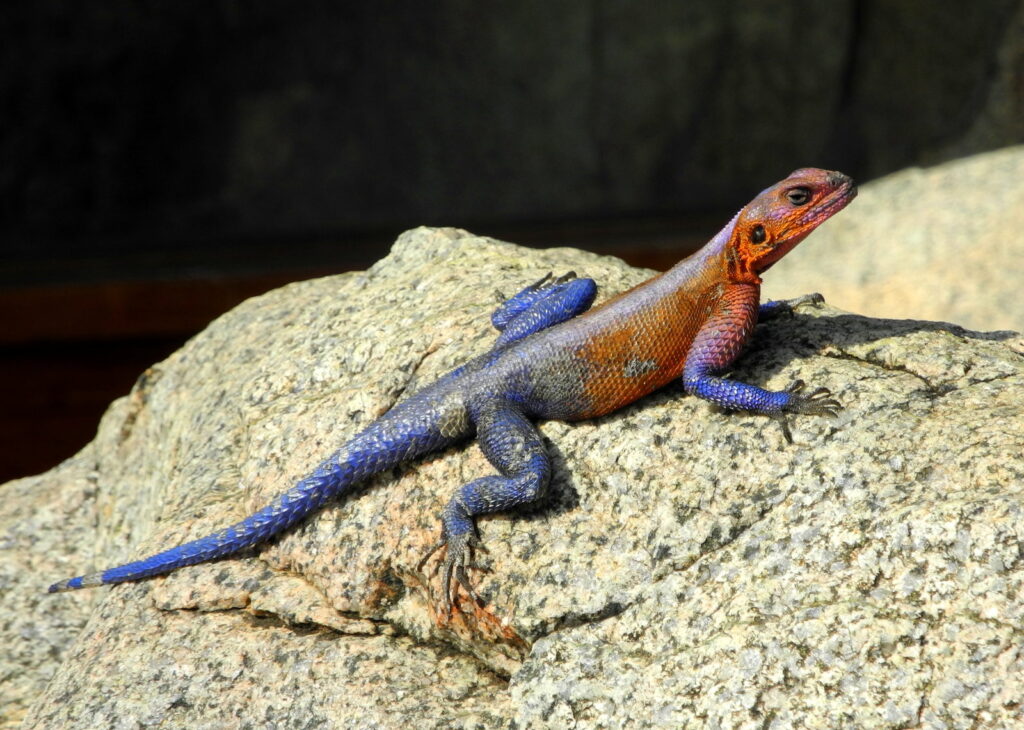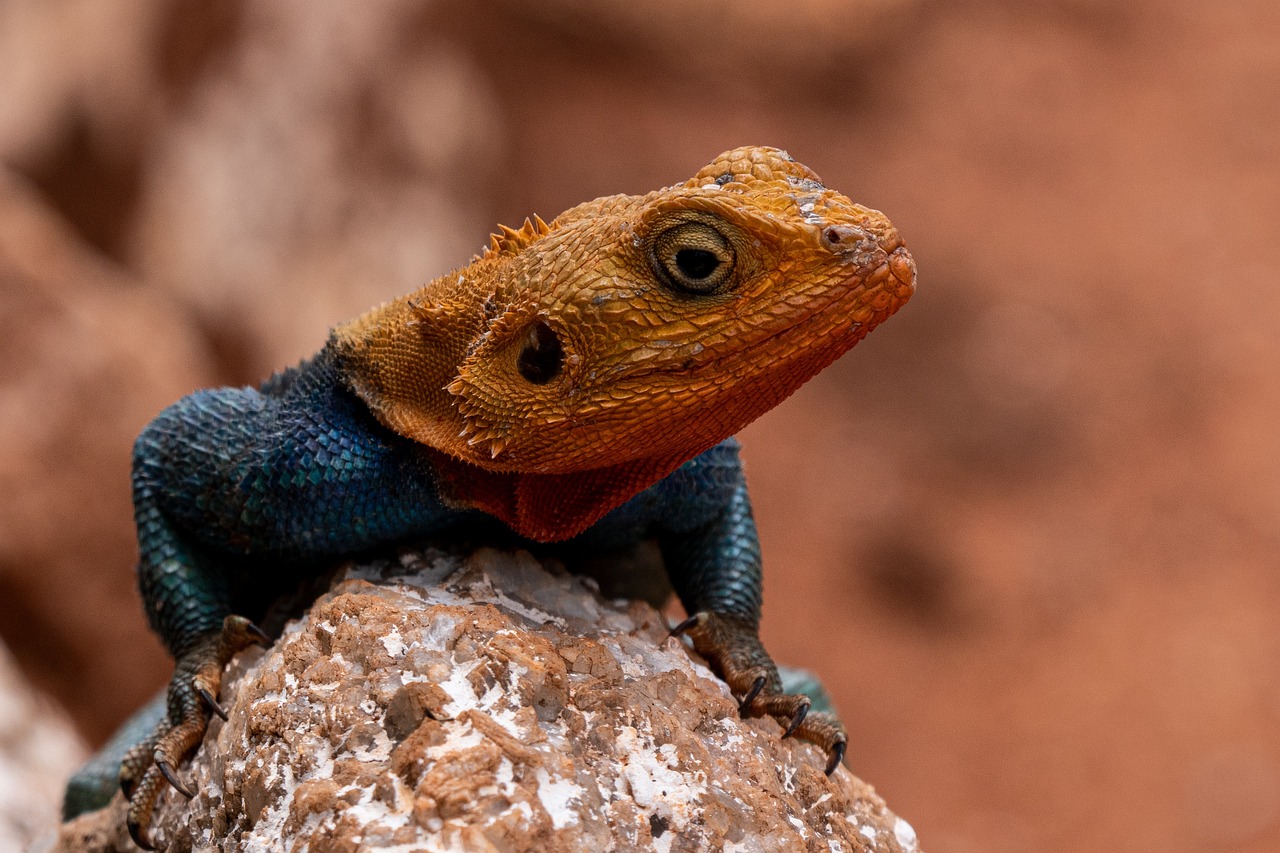Have you ever walked through a forest, spotted something red flash past, and realized you’ve just witnessed one of nature’s most intriguing marvels – a red-headed lizard? Let’s set the scene. Imagine you’re traipsing through a dense forest, the earthy scent of damp leaves filling your senses, when out of the corner of your eye, you spot a dash of fiery red. That, dear reader, is the exciting world we’re about to delve into.
Welcome to the realm of red-headed lizards, where life is not only about survival but also a dazzling show of colors. In this blog post, we’re going on a fascinating journey to uncover the secrets of these vibrant reptiles, their captivating red crowns, and how they add a splash of color to our natural world. So grab your explorer hat, your curiosity, and let’s get started!
Meet the Red-Headed Lizards
Picture a lizard. You’re probably visualizing a green or brown creature, blending seamlessly with its surroundings. Now, let’s paint a different picture, one with a bold stroke of red. Intriguing, isn’t it?
Red-headed lizards, often known as the Erythrophora (the Greek name translating to “bearer of red”), are a dazzling divergence from the usual greens and browns we associate with their kind. They’re typically found scurrying around the warm, sun-bathed landscapes of South and Central America, Africa, and parts of Asia.
These fiery reptiles are a sight to behold. Their most prominent feature, of course, is the vivid, red coloring on their heads. It’s as if someone dipped a paintbrush in a palette of bright red and decided to give these creatures an artistic makeover. This scarlet hue isn’t the only thing that’s captivating about these lizards. Their scalloped bodies, uniquely shaped eyes, and the swiftness of their movements contribute to their exotic charm.
One fun fact to pique your curiosity: despite their name, not all red-headed lizards are males. Yes, you read that right. The females often sport the same vibrant headgear, debunking the myth that in the world of animals, only males get to dress fancy.
The Science Behind the Red Heads
Now that we’ve gotten acquainted with our colorful friends let’s dig a bit deeper into why they sport such flamboyant heads. It’s not just a random twist of nature but a product of meticulous evolution.
The red-headed coloration is not merely for show. It’s a combination of genetics and the complex science of survival. Evolutionary biologists believe this red coloring could be a form of aposematism – a fancy term meaning that these lizards are using their vivid coloration to signal potential predators to back off.
On the flip side, there’s another theory suggesting that the crimson hue aids in attracting a mate. You see, in the reptile world, brighter is better. A vibrant red head might just be the perfect way to catch the eye of a potential partner.
However, as always, beauty comes with a cost. The eye-catching red color could make these lizards an easy target for predators. It’s a delicate balance between standing out for mates and not standing out too much for predators. Ah, the dilemmas of being a red-headed lizard!
Stay tuned, as up next, we’re diving into the everyday life of these captivating creatures, where every day is a red-letter day!
Life in the Red Zone : Red-Headed Lizards

Feeding Habits and Preferred Prey
Red-headed lizards, much like their reptile counterparts, lead an insectivorous lifestyle. That’s a science-y way of saying they eat insects – a lot of them! You’ll often find these reptiles skulking in the undergrowth, ready to pounce on an unwary cricket or snatch a juicy caterpillar off a leaf. From beetles to spiders, their diet is as diverse as their vibrant coloration.
Here’s a peek into a typical red-headed lizard’s daily menu:
| Mealtime | Preferred Prey |
|---|---|
| Breakfast | Spider or Ants |
| Lunch | Beetle or Grasshopper |
| Dinner | Moth or Crickets |
Typical Behavior
Have you ever basked in the sun, soaking up its warmth, and felt a sense of tranquility wash over you? If your answer is yes, you share a love for sunbathing with our red-headed friends. These lizards are diurnal, meaning they’re most active during the day. Most of their daylight hours are spent basking on sunlit rocks or scurrying around in search of their next meal.
But don’t be fooled by their love for sunlight. When it comes to playing hide and seek, these lizards are experts. They are proficient at blending into their surroundings, and when threatened, they will make a swift dash to the nearest crevice or under a leaf litter.
Interesting story to note: once, while observing these colorful creatures in their natural habitats, a red-headed lizard dashed across our path so quickly that it left us wondering if we’d seen a streak of sunlight or a tiny, living fireball!
The Red-Headed Lizard Family Album

Now that we’ve learned about the habits and behaviors of these vivid lizards let’s delve into the family album, meeting different species from around the globe.
- The Broad-Headed Skink: Native to the southeastern United States, this species exhibits striking red or orange heads during the mating season, especially the males.
- The Common Flat Lizard: Found in South Africa, both males and females of this species boast bright red or orange heads, making them a favorite among reptile enthusiasts.
- The Fiery Dragon Lizard: A resident of Indonesia, this lizard has a rich red head, contrasting sharply with its otherwise green body.
Remember, while each species shares the red-headed characteristic, they each have their own unique traits, behaviors, and habitats that make them special in their own right.
Conservation Concerns for Red-Headed Lizards
Our colorful friends, while radiant and resilient, aren’t immune to the challenges that affect many species around the world. Habitat loss, climate change, and even pet trade pose significant threats to the survival of red-headed lizards.
Many of these lizards reside in areas of the world undergoing rapid development, leading to a loss of their natural habitats. Logging, mining, and urban expansion all contribute to this threat. Additionally, climate change alters the environments these lizards call home, sometimes making them inhospitable.
If that wasn’t enough, some species are popular in the pet trade. While it might be tempting to own one of these fiery-headed creatures, remember that every wild lizard taken as a pet is one less contributing to the population in the wild.
While the picture might seem grim, there is a silver lining. Many organizations and individuals worldwide are working tirelessly to protect and preserve these reptiles’ habitats. And here’s the good news: you can help too.
- Learn and educate others about these fascinating creatures.
- Support legislation that protects natural habitats.
- Donate to or volunteer with organizations dedicated to reptile conservation.
In essence, each of us holds a small piece of the solution in our hands.
Final Thougths on The Red-Headed Lizards
It’s been quite a journey exploring the fiery world of red-headed lizards, hasn’t it? We’ve delved into their vibrant lives, taken a peek into their family album, and understood the threats they face.
These colorful creatures, with their scarlet heads and fascinating behaviors, add a dash of color to our world, a world that would be less beautiful without them. So the next time you spot a streak of red scurrying across a rock or notice a fiery head peeking from a leaf’s shadow, take a moment. Appreciate these little wonders of nature, and remember, each of us can play a part in ensuring their survival.
After all, in the grand tapestry of life, every thread counts, especially the brilliantly red ones.
FAQ on The Red-Headed Lizards
Red-headed lizards are known for their distinctive fiery red coloration on their heads. This striking feature, along with their fascinating behaviors, makes them unique among reptile species.
The red-headed coloration in lizards is an evolutionary adaptation that may have several benefits, such as camouflage, attracting mates, or warning predators. The exact reason can vary among different species and is often a subject of scientific research.
Red-headed lizards face various threats, including habitat loss due to human activity, climate change, and capture for the pet trade. These challenges can significantly impact their populations in the wild.
You can contribute to the conservation of red-headed lizards by learning about these creatures, educating others, supporting legislation that protects their habitats, and volunteering or donating to organizations dedicated to reptile conservation.
No, the term “red-headed lizards” can refer to various species around the world that share the common characteristic of having red heads. These species can differ significantly in size, behavior, and other traits.
Red-headed lizards, like many lizard species, are primarily insectivores. They prefer a diet of small invertebrates, including beetles, spiders, and caterpillars. However, the exact diet can vary among different species.
While some species of red-headed lizards can adapt to life in captivity, it’s important to remember that they are wild animals. Their capture for the pet trade can harm wild populations.
If you wish to keep a red-headed lizard as a pet, consider adopting from a reputable breeder who follows ethical practices. Always ensure that you can provide the appropriate care and environment for your pet.


